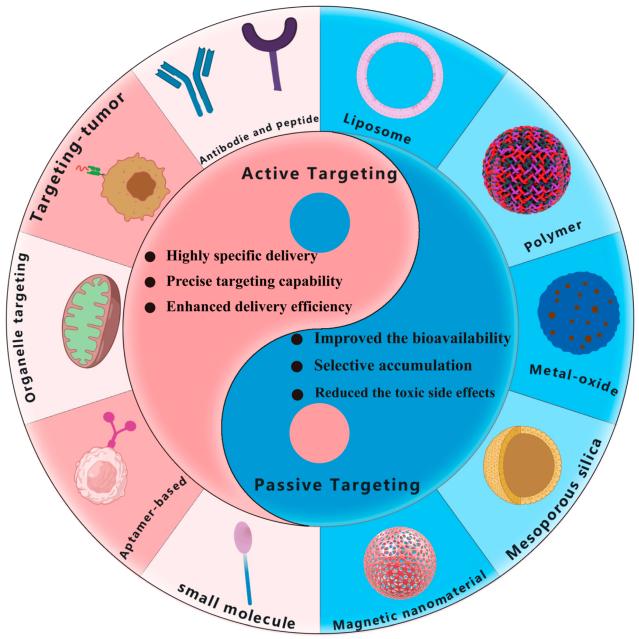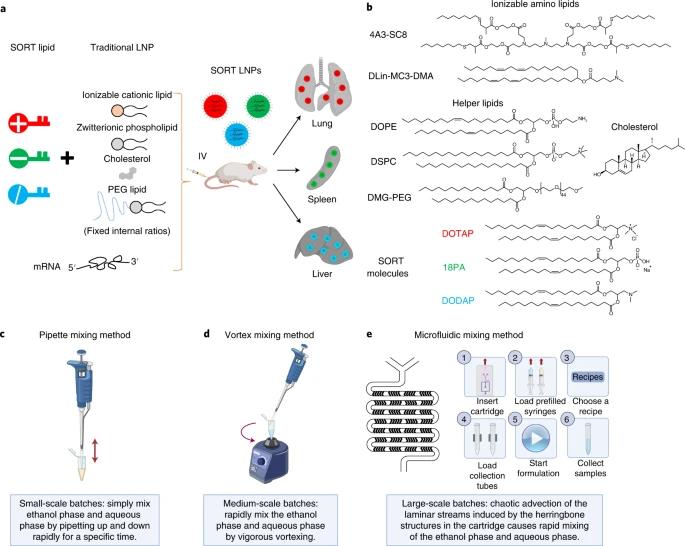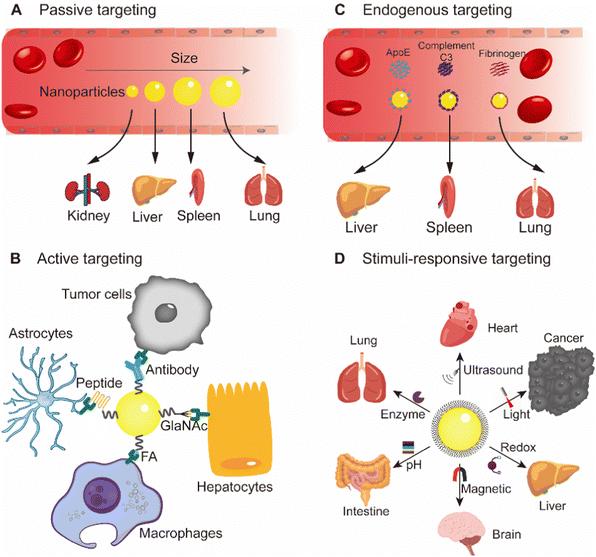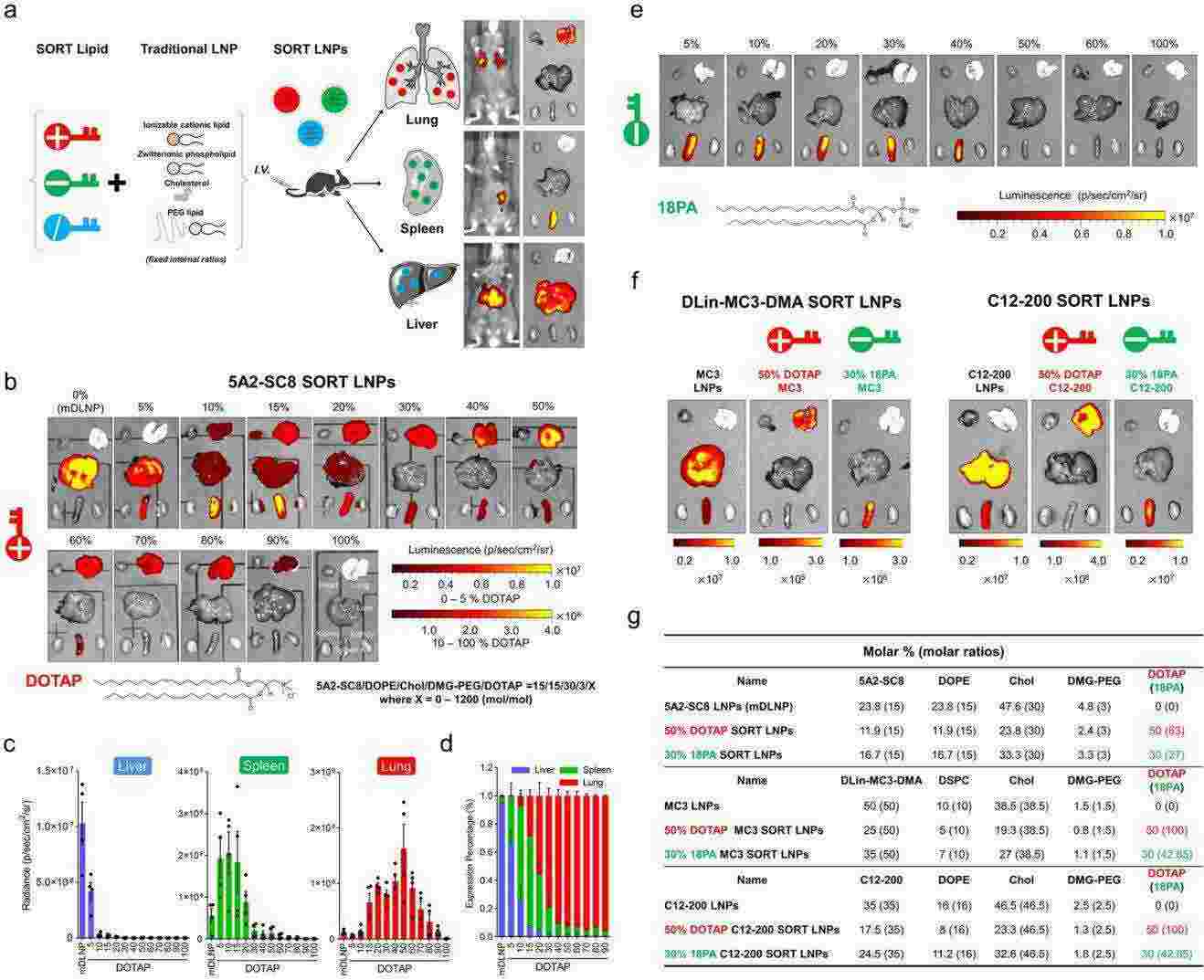Selective Organ Targeting Nanoparticle Platform for Nanoformulations
Inquiry
Selective organ targeting (SORT) is a new approach in targeted drug delivery that systematically designs multiple classes of lipid nanoparticles to enable targeted delivery of therapeutic drugs to specific organs in the body, such as the liver, lungs, heart, etc. CD Formulation has constructed a selective organ-targeting nanoparticle platform and can provide customers with the preparation, characterization, commercial production, and clinical transformation of selective organ-targeting nanoparticles.
Advantages of Selective Organ Targeting Nanoparticles
Selective organ targeting enables the prediction of nanoparticle delivery of RNA to specific organs, helping to develop new protein replacement and gene correction therapies. Since delivery efficiency is closely related to modular molecular classes, this approach can be widely applied to existing lipid nanoparticle systems and other nanoparticle systems to rationally design carriers based on delivered substances and organ properties. And nanocarrier-based targeting drug delivery systems are mainly active targeting and passive targeting.
 Fig.1 Schematic illustration of nanocarrier-based active and passive targeting drug delivery systems. (Jianmin Li, et al. 2023)
Fig.1 Schematic illustration of nanocarrier-based active and passive targeting drug delivery systems. (Jianmin Li, et al. 2023)
At the selective organ-targeting nanoparticle platform, we can use the strategy of selective organ-targeting to deliver nanoformulations to therapeutically relevant cells to achieve the purpose of disease treatment. The advantages of selective organ-targeting nanoparticle platforms are as follows.
- Selective organ-targeting molecules modify tissue tropism by adjusting the composition and physical properties of the nanoparticles.
- Addition of permanent cationic lipids, permanent anionic lipids, or ionizable amino lipids can increase delivery to the lungs, spleen, and liver.
- Selective organ targeting lipid nanoparticles utilize selective organ targeting molecules to precisely tune and mediate gene delivery and editing, resulting in predictable and manageable protein synthesis of mRNA in specific organs, which can potentially improve drug efficacy while reducing side effects.
Our Fabrication of Selective Organ Targeting Nanoparticles
CD Formulation has been committed to researching preparation methods for selective organ-targeting nanoparticles for years, especially selective organ-targeting lipid nanoparticles (SORT LNPs).
Design of SORT LNP Preparation
Lipid nanoparticles are composed of ionizable cationic lipids, amphiphilic phospholipids, cholesterol and PEG lipids. We added selective organ-targeting molecules to lipid nanoparticles to systematically change the in vivo delivery properties of the resulting SORT LNPs, enabling tissue-specific delivery of mRNA to the liver, lungs and spleen of mice.
SORT LNP Preparation Methods
We used three mixing methods to prepare SORT LNP formulations, namely pipette mixing, vortex mixing and microfluidic mixing methods.
Pipette mixing is the most common method for preparing small-scale batches of LNPs for optimization, characterization, in vitro studies, and low-dose in vivo studies. This mixing method involves rapid up and down pipetting by hand for a specific period of time to mix the two solutions to form nanoparticles.
Vortex mixing is a common method to prepare medium-scale batches of LNPs for optimization, characterization, in vitro and in vivo studies. The method consists of rapidly mixing two solutions for a period of time under vigorous vortexing to form nanoparticles.
Microfluidic mixing is a common method for preparing medium to large batches of LNPs for in vitro studies, in vivo studies, and clinical use.
 Fig.2 Experimental design for preparation of liver, lung and spleen SORT LNPs. (Xu Wang, et al. 2023)
Fig.2 Experimental design for preparation of liver, lung and spleen SORT LNPs. (Xu Wang, et al. 2023)
Our Strategies at Selective Organ Targeting Nanoparticle Platform
Organ-selective nanodrug delivery by tuning the physical and chemical properties of nanoparticle drug delivery systems, thereby regulating their biodistribution, is a rational strategy for the precise treatment of organ-associated cancers.
Passive Targeting
Passive targeting is a targeting strategy that transfers nanoparticles to the target area through endocytosis and adsorption of various tissues and cells, capillary encapsulation, or utilizing the high permeability of diseased tissue blood vessels.
Active Targeting
Active targeting is to load therapeutic molecules through surface modification, transport the therapeutic molecules to the target area, and exert therapeutic effects. Actively targeted nanoparticles mainly include ligands (such as targeting small molecules, aptamers, targeting peptides, antibodies or antibody fragments, cells, etc.), connectors and cargoes (such as various therapeutic molecules, such as small molecule drugs, nucleic acids, therapeutic peptides, etc.).
Endogenous Targeting
Endogenous targeting is the process of engineering the composition of nanoparticles (such as lipid nanoparticles) so that they bind to different plasma proteins in the blood, thereby directing them to target organs and promoting uptake by specific cells.
Stimulus-response Targeting
Stimulus-responsive targeting utilizes the properties of nanomaterials themselves, which can be switched under specific conditions. When nanoparticles are stimulated by conditions such as light, ultrasound, temperature, magnetic field, chemical reactions, etc., their size, surface groups, and movement will change, thereby determining the nanoparticle targeting design site.
 Fig.3 Serial targeting strategies using nanoparticles. (Jian Li, et al. 2023)
Fig.3 Serial targeting strategies using nanoparticles. (Jian Li, et al. 2023)
Highlights of Our Selective Organ Targeting Nanoparticle Platform
- Relying on our advanced selective organ-targeting nanoparticle platform, we have accumulated rich experience in the construction of selective organ-targeting nanoparticles, especially selective organ-targeting lipid nanoparticles for mRNA delivery.
- We have explored and researched four strategies for designing and preparing selective organ targeting nanoparticles, such as passive targeting, active targeting, endogenous targeting and stimulus-responsive targeting strategy.
- We also have rich experience in quality analysis of selective organ targeting nanoparticles including characterization of surface targeting ligands, in vitro drug release, stability, etc.
Custom Targeting Nanoformulation Development Services
We have always been concerned with the development and research of targeting nanoformulations. Based on our advanced selective organ targeting nanoparticle platform, we provide customers with targeting nanoformulation development and customization services. Our professional team has conducted in-depth research on the preparation technology of targeting nanoformulations and can develop targeting nanoformulations for different clinical applications, which has rapidly promoted the clinical transformation and commercial application of targeting nanoformulations.
Targeting Nanoformulation Development
Using our selective organ targeting nanoparticle platform, we can swiftly customize various targeting nanoformulations to meet personalized customer needs. With thorough research on their preparation process, we offer professional customization solutions to improve the targeting and bioavailability of these nanoformulations.
Published Data
Technology: Selective organ targeting (SORT) strategy
Journal: Nature Nanotechnology
IF: 38.1
Published: 2020
Results:
The authors propose a strategy of selective organ targeting (SORT), in which multiclass lipid nanoparticles are systematically designed to specifically edit extrahepatic tissues by adding complementary SORT molecules. SORT lipid nanoparticles targeting the lung, spleen, and liver are designed to selectively edit therapeutically relevant cell types, including epithelial cells, endothelial cells, B cells, T cells, and hepatocytes. SORT is compatible with a variety of gene editing technologies, including mRNA, Cas9 mRNA/single guide RNA, and Cas9 ribonucleoprotein complexes, and is designed to help researchers develop protein replacement and gene correction therapies in targeted tissues.
 Fig.4 Selective organ targeting allows lipid nanoparticles to be systematically and predictably engineered to accurately deliver mRNA into specific organs. (Qiang Cheng, et al. 2020)
Fig.4 Selective organ targeting allows lipid nanoparticles to be systematically and predictably engineered to accurately deliver mRNA into specific organs. (Qiang Cheng, et al. 2020)
Nanoformulations can serve as therapeutic agents and delivery carriers to organs like the heart, liver, and lungs. They enhance therapeutic effects, target specific organs, and reduce nonspecific side effects. CD Formulation specializes in developing selective organ-targeting nanoparticles with our innovative platform. If you are interested in our selective organ-targeting nanoparticle platform, please contact us.
References
- Jianmin Li, Qingluo Wang,Guoyu Xia, et al. Recent Advances in Targeted Drug Delivery Strategy for Enhancing Oncotherapy. Pharmaceutics. 2023, 15(9):2233.
- Xu Wang, Shuai Liu, Yehui Sun, et al. Preparation of selective organ-targeting (SORT) lipid nanoparticles (LNPs) using multiple technical methods for tissue-specific mRNA delivery. Nature Protocols. 2023,18:265-291.
- Jian Li, Hai Wang. Selective organ targeting nanoparticles: from design to clinical translation. Nanoscale Horiz. 2023, 8, 1155-1173.
- Qiang Cheng, Tuo Wei, Lukas Farbiak, et al. Selective organ targeting (SORT) nanoparticles for tissue-specific mRNA delivery and CRISPR-Cas gene editing. Nature Nanotechnology. 2020,15(4):313-320.
How It Works
STEP 2
We'll email you to provide your quote and confirm order details if applicable.
STEP 3
Execute the project with real-time communication, and deliver the final report promptly.
Related Services


 Fig.1 Schematic illustration of nanocarrier-based active and passive targeting drug delivery systems. (Jianmin Li, et al. 2023)
Fig.1 Schematic illustration of nanocarrier-based active and passive targeting drug delivery systems. (Jianmin Li, et al. 2023) Fig.2 Experimental design for preparation of liver, lung and spleen SORT LNPs. (Xu Wang, et al. 2023)
Fig.2 Experimental design for preparation of liver, lung and spleen SORT LNPs. (Xu Wang, et al. 2023) Fig.3 Serial targeting strategies using nanoparticles. (Jian Li, et al. 2023)
Fig.3 Serial targeting strategies using nanoparticles. (Jian Li, et al. 2023) Fig.4 Selective organ targeting allows lipid nanoparticles to be systematically and predictably engineered to accurately deliver mRNA into specific organs. (Qiang Cheng, et al. 2020)
Fig.4 Selective organ targeting allows lipid nanoparticles to be systematically and predictably engineered to accurately deliver mRNA into specific organs. (Qiang Cheng, et al. 2020)
